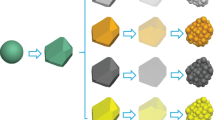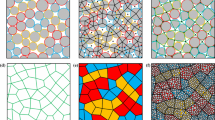Abstract
The microstructure of rock is one of the most important factors that affect its mechanical behaviors. In order to study the effects of grain size on the strength and failure behaviors of granites, a breakable polygonal grain–based discrete-element model is developed to simulate the microstructure of rocks. In the model, mineral grain types, grain size distributions, and mineralogical composition are incorporated, and the intergranular and intragranular cracks are captured in the failure process. Using this method, six kinds of specimen with varying grain size are established, and the effects of grain size on peak strength, deformation properties, microcrack distributions, and macroscopic failure pattern are studied through conducting a series of compressive loading tests. The results indicate that rock strength is inversely proportional to the grain size, while a decreasing tendency in peak strain, an increasing tendency in Young’s modulus, and Poisson’s ratio with the grain size are observed. Meanwhile, an increase of grain size also results in a dramatic rise in crack initiation stress, ratios of shear cracks/intragranular cracks to generated total cracks. Under uniaxial compression tests, rocks consisted of small grains are trend to fracture with a single shear band, while rocks consisted of large grains are trend to fracture with an axial splitting. The failure pattern of rocks under high confining pressure is mainly double shear in a “X” fashion, and the width of fractures increases as the grain size increases. The proposed model provides a reliable method for investigating the influences of grain size on the rock mechanical behaviors in microscopic scale, and the results can be used to predict the macroscopic behaviors of brittle rocks.




















Similar content being viewed by others
References
Blair SC, Cook NGW (1998) Analysis of compressive fracture in rock using statistical techniques: part II. effect of microscale heterogeneity on macroscopic deformation. Int J Rock Mech Min Sci 35:849–861. https://doi.org/10.1016/S0148-9062(98)00009-6
Brace WF (1961) Dependence of fracture strength of rocks on grain size. 4th US Symp Rock Mech Univ Park USA 76:99–103
Chen JH, Liu P, Zhao HB, Zhang C, Zhang JW (2021). Analytical studying the axial performance of fully encapsulated rock bolts. Eng Fail Anal 128:105580
Diederichs MS (2003) Manuel Rocha medal recipient rock fracture and collapse under low confinement conditions. Rock Mech Rock Eng 36:339–381. https://doi.org/10.1007/s00603-003-0015-y
Eberhardt E, Stimpson B, Stead D (1999) Effects of grain size on the initiation and propagation thresholds of stress-induced brittle fractures. Rock Mech Rock Eng 32:81–99. https://doi.org/10.1007/s006030050026
Fredrich JT, Evans B, Wong TF (1990) Effect of grain size on brittle and semibrittle strength: implications for micromechanical modelling of failure in compression. J Geophys Res Solid Earth 95:10907–10920
Gao F, Kang H (2017) Grain-based discrete-element modeling study on the effects of cementation on the mechanical behavior of low-porosity brittle rocks. Int J Geomech 17:04017061. https://doi.org/10.1061/(asce)gm.1943-5622.0000957
Gao F, Stead D, Elmo D (2016) Numerical simulation of microstructure of brittle rock using a grain-breakable distinct element grain-based model. Comput Geotech 78:203–217. https://doi.org/10.1016/j.compgeo.2016.05.019
Gao FQ, Stead D (2014) The application of a modified Voronoi logic to brittle fracture modelling at the laboratory and field scale. Int J Rock Mech Min Sci 68:1–14. https://doi.org/10.1016/j.ijrmms.2014.02.003
Ghazvinian E, Diederichs MS, Quey R (2014) 3D random Voronoi grain-based models for simulation of brittle rock damage and fabric-guided micro-fracturing. J Rock Mech Geotech Eng 6:506–521. https://doi.org/10.1016/j.jrmge.2014.09.001
Gui YL, Zhao ZY, Ji J, Wang XM, Zhou KP, Ma SQ (2016) The grain effect of intact rock modelling using discrete element method with Voronoi grains. Géotech Lett 6:136–143. https://doi.org/10.1680/jgele.16.00005
Hofmann H, Babadagli T, Yoon JS, Zang A, Zimmermann G (2015a) A grain based modeling study of mineralogical factors affecting strength, elastic behavior and micro fracture development during compression tests in granites. Eng Fract Mech 147:261–275. https://doi.org/10.1016/j.engfracmech.2015.09.008
Hofmann H, Babadagli T, Zimmermann G (2015b) A grain based modeling study of fracture branching during compression tests in granites. Int J Rock Mech Min Sci 77:152–162. https://doi.org/10.1016/j.ijrmms.2015.04.008
Hsieh YM, Li HH, Huang TH, Jeng FS (2008) Interpretations on how the macroscopic mechanical behavior of sandstone affected by microscopic properties—revealed by bonded-particle model. Eng Geology 99:1–10. https://doi.org/10.1016/j.enggeo.2008.01.017
Jiao MR, Wong RHC, Wong TF, Chau KT, Tang CA (2004) Numerical simulation of the influence of grain size on the progressive development of brittle failure in Yuen long marbles. Key Eng Mater 261–263:1511–1516. https://doi.org/10.4028/www.scientific.net/KEM.261-263.1511
Justo J, Konietzky H, Castro J (2020) Discrete numerical analyses of grain size influence on the fracture of notched rock beams. Comput Geotech 125:103680. https://doi.org/10.1016/j.compgeo.2020.103680
Kazerani T (2013) Effect of micromechanical parameters of microstructure on compressive and tensile failure process of rock. Int J Rock Mech Min Sci 64:44–55. https://doi.org/10.1016/j.ijrmms.2013.08.016
Kazerani T, Zhao J (2013) A microstructure-based model to characterize micromechanical parameters controlling compressive and tensile failure in crystallized rock. Rock Mech Rock Eng 47:435–452. https://doi.org/10.1007/s00603-013-0402-y
Koyama T, Jing L (2007) Effects of model scale and particle size on micro-mechanical properties and failure processes of rocks—a particle mechanics approach. Eng Anal Bound Elem 31:458–472. https://doi.org/10.1016/j.enganabound.2006.11.009
Lan H, Martin CD, Hu B (2010) Effect of heterogeneity of brittle rock on micromechanical extensile behavior during compression loading. J Geophys Res 115. https://doi.org/10.1029/2009jb006496
Li J, Konietzky H, Frühwirt T (2017) Voronoi-based DEM simulation approach for sandstone considering grain structure and pore size. Rock Mech Rock Eng 50:2749–2761. https://doi.org/10.1007/s00603-017-1257-4
Li K, Cheng Y, Fan X (2018) Roles of model size and particle size distribution on macro-mechanical properties of Lac du Bonnet granite using flat-joint model. Comput Geotech 103:43–60. https://doi.org/10.1016/j.compgeo.2018.07.007
Liu G, Cai M, Huang M (2018) Mechanical properties of brittle rock governed by micro-geometric heterogeneity. Comput Geotech 104:358–372. https://doi.org/10.1016/j.compgeo.2017.11.013
Liu Q, Wang W, Ma H (2020) Parallelized combined finite-discrete element (FDEM) procedure using multi-GPU with CUDA 44:208–238. https://doi.org/10.1002/nag.3011
Mahabadi OK, Tatone BSA, Grasselli G (2014) Influence of microscale heterogeneity and microstructure on the tensile behavior of crystalline rocks. J Geophys Res: Solid Earth 119:5324–5341. https://doi.org/10.1002/2014jb011064
Manso J, Marcelino J, Caldeira L (2019) Effect of the clump size for bonded particle model on the uniaxial and tensile strength ratio of rock. Int J Rock Mech Min Sci 114:131–140. https://doi.org/10.1016/j.ijrmms.2018.12.024
Nicksiar M, Martin CD (2012) Evaluation of methods for determining crack initiation in compression tests on low-porosity rocks. Rock Mech Rock Eng 45:607–617. https://doi.org/10.1007/s00603-012-0221-6
Nicksiar M, Martin CD (2013) Factors affecting crack initiation in low porosity crystalline rocks. Rock Mech Rock Eng 47:1165–1181. https://doi.org/10.1007/s00603-013-0451-2
Olsson WA (1974) Grain size dependence of yield stress in marble. J Geophys Res 79:4859–4862
Peng J, Wong LNY, Teh CI (2017) Effects of grain size-to-particle size ratio on micro-cracking behavior using a bonded-particle grain-based model. Int J Rock Mech Min Sci 100:207–217. https://doi.org/10.1016/j.ijrmms.2017.10.004
Potyondy D (2010) A grain-based model for rock: approaching the true microstructure. Proc Rock Mech Nordic Countries 225–234
Potyondy DO, Cundall PA (2004) A bonded-particle model for rock. Int J Rock Mech Min Sci 41:1329–1364. https://doi.org/10.1016/j.ijrmms.2004.09.011
Saadat M, Taheri A (2019a) Modelling micro-cracking behaviour of pre-cracked granite using grain-based distinct element model. Rock Mech Rock Eng 52:4669–4692. https://doi.org/10.1007/s00603-019-01862-0
Saadat M, Taheri A (2019b) A numerical approach to investigate the effects of rock texture on the damage and crack propagation of a pre-cracked granite. Comput Geotech 111:89–111. https://doi.org/10.1016/j.compgeo.2019.03.009
Saadat M, Taheri A (2020) Modelling micro-cracking behaviour of granite during direct tensile test using cohesive GBM approach. Eng Fract Mech 239:107297. https://doi.org/10.1016/j.engfracmech.2020.107297
Saadat M, Taheri A, Kawamura Y (2021) Investigating asperity damage of natural rock joints in polycrystalline rocks under confining pressure using grain-based model. Comput Geotech 135:104144. https://doi.org/10.1016/j.compgeo.2021.104144
Singh SK (1988) Relationship among fatigue strength, mean grain size and compressive strength of a rock. Rock Mech Rock Eng 21:271–276. https://doi.org/10.1007/BF01020280
Tang CA, Liu H, Lee PKK, Tsui Y, Tham LG (2000) Numerical studies of the influence of microstructure on rock failure in uniaxial compression—part I: effect of heterogeneity. Int J Rock Mech Min Sci 37:555–569. https://doi.org/10.1016/S1365-1609(99)00121-5
Tapponnier P, Brace WF (1976) Development of stress-induced microcracks in Westerly granite. Int J Rock Mech Min Sci Geomech Abstr 13:103–112. https://doi.org/10.1016/0148-9062(76)91937-9
Wang W, Liu Q, Ma H, Lu H, Wang Z (2020) Numerical analysis of material modeling rock reinforcement in 2D FDEM and parameter study. Comput Geotech 126:103767. https://doi.org/10.1016/j.compgeo.2020.103767
Wasantha PLP, Ranjith PG, Zhao J, Shao SS, Permata G (2015) Strain rate effect on the mechanical behaviour of sandstones with different grain sizes. Rock Mech Rock Eng 48:1883–1895. https://doi.org/10.1007/s00603-014-0688-4
Wong RHC, Chau KT, Wang P (1996) Microcracking and grain size effect in Yuen Long marbles. Int J Rock Mech Min Sci Geomech Abstr 33:479–485. https://doi.org/10.1016/0148-9062(96)00007-1
Weng MC, Li HH (2012) Relationship between the deformation characteristics and microscopic properties of sandstone explored by the bonded-particle model. Int J Rock Mech Min Sci 56:34–43. https://doi.org/10.1016/j.ijrmms.2012.07.003
Wong T-f, Wong RHC, Chau KT, Tang CA (2006) Microcrack statistics, Weibull distribution and micromechanical modeling of compressive failure in rock. Mech Mater 38:664–681. https://doi.org/10.1016/j.mechmat.2005.12.002
Wong L, Yuen N, Jun P, Cee T (2017) Influence of grain size heterogeneity on strength and microcracking behavior of crystalline rocks. J Geophys Res Solid Earth 1054–1073
Wu S, Ramandi HL, Chen H, Crosky A, Hagan P, Saydam S (2019) Mineralogically influenced stress corrosion cracking of rockbolts and cable bolts in underground mines. Int J Rock Mech Min Sci 119:109–116. https://doi.org/10.1016/j.ijrmms.2019.04.011
Wu S, Wang X (2020) Investigation for influences of seepage on mechanical properties of rocks using acoustic emission technique. Geofluids. https://doi.org/10.1155/2020/6693920
Zhang F (2007) Study on mechanical behavior and constitutive relations of the Three Gorges granite. Wuhan Institute of Rock and Soil Mechanics. The Chinese Academy of Sciences, P. R. China
Zhou Y (2015) An equivalent crystal model for Mesoscopic behaviour of rock. Chin J Rock Mech Eng 34:511–519
Zhou J, Lan H, Zhang L, Yang D, Song J, Wang S (2019) Novel grain-based model for simulation of brittle failure of Alxa porphyritic granite. Eng Geol 251:100–114. https://doi.org/10.1016/j.enggeo.2019.02.005
Zhu ZQ (2008) Study on formation mechanism of excavation disturbed zone of hard fractured rockmass. The Chinese Academy of Sciences (Wuhan Institute of Rock and Soil Mechanics)
Funding
This work is supported by the National Natural Science Foundation of China (52004196, 51904220) and the Department of Education Scientific Research Program of Shanxi province (20JK0724).
Author information
Authors and Affiliations
Corresponding authors
Ethics declarations
Conflict of interest
The authors declare no competing interests.
Additional information
Highlights
• A breakable polygonal grain–based model was developed to simulate the microstructure of granites, and the mineral grain types, grain size distributions, and mineralogical composition in rock are incorporated. Both intergranular and intragranular cracks can be mimicked in the model.
• Rock strength is inversely proportional to the grain size, while a decreasing tendency in peak strain, an increasing tendency in Young’s modulus, and Poisson’s ratios with the grain size are observed.
• Under uniaxial compression tests, rocks consisted of small grains are trend to fracture with a single shear band, while rocks consisted of large grains are trend to fracture with an axial splitting. The failure pattern of rocks under high confining pressure is mainly double shear in a “X” fashion, and the width of fractures increases as the grain size increases.
Rights and permissions
About this article
Cite this article
Wang, Z., Wang, T., Wu, S. et al. Investigation into the effects of grain size on strength and failure behaviors of granites using a breakable polygonal grain–based model. Bull Eng Geol Environ 80, 6989–7007 (2021). https://doi.org/10.1007/s10064-021-02354-8
Received:
Accepted:
Published:
Issue Date:
DOI: https://doi.org/10.1007/s10064-021-02354-8




